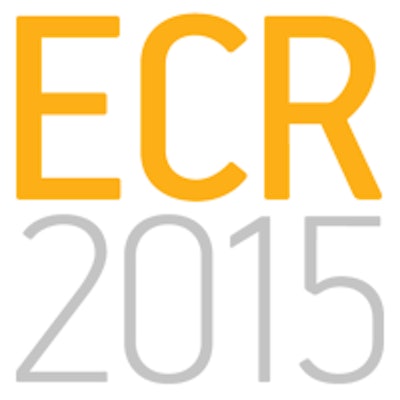
VIENNA - Although they often have concerns about its potential impact on their practice, Italian radiologists still typically have a positive view of teleradiology and believe it has a bright future, according to a presentation on Sunday at ECR 2015.
In an online survey of Italian radiologists, a research team led by Dr. Francesca Coppola, of S. Orsola-Malpighi Hospital in Bologna, found that nearly two-thirds of survey participants had a favorable opinion of teleradiology and that 80% believe teleradiology has a bright future. On the downside, nearly two-thirds reported fears that teleradiology may cause them to lose control of their business or to lose their job.
The researchers had set out to learn about the current diffusion of teleradiology in Italy and to discover if teleradiology activities were compliant with Italian guideline recommendations. They also sought to gather information on radiologists' opinions on teleradiology, according to Coppola.
She noted that current Italian guidelines only support the use of intramural applications, such as within the same institution-hospital for routine reporting or second opinion, within the same institution-hospital temporarily for emergency exams during night shifts or weekends, screening programs for first or second readers, and research purposes.
The survey included 19 multiple-choice questions, along with space for participants to add any personal comments. Each radiologist in the Italian Society of Medical Radiology (SIRM) received a personal email from the president of the SIRM Informatics Working Group with an invitation to participate in the online survey.
Among the 9,662 radiologists in SIRM, 1,599 (17%) participated in the survey. Of these, 79% worked in a public organization, while 21% were at a private institution. Academics or directors of radiology units made up 29% of the responses, while only 8% were residents.
The researchers found that 874 (55%) were working with some form of teleradiology.
"The majority of radiologists using teleradiology adopt an intramural solution, which means that they report at distance, receiving examinations from a radiology unit usually located in a different hospital but property of the same institution," Coppola said.
The most common applications for intramural teleradiology were emergency examinations (47%), on-call coverage at night or on holidays (37%), and for better distribution of the radiological workload (33%), she said. Only 12% of respondents said they outsource examinations from their institution, a practice that is contrary to SIRM guidelines.
"However, outsourcing is adopted more frequently in private institutions than in public [28% versus 9%]," she said.
Approximately the same number of radiologists receive requests for or ask for a second opinion via teleradiology, according to Coppola. Neuroradiology contributes approximately one-third of all second-opinion requests.
Positive opinions
Of the participants who were already using teleradiology, 68% believed that teleradiology was an advantage. However, only 53% of radiologists who were not using teleradiology felt that way.
The researchers also found a higher rate of positive opinion among radiologists working in private institutions than in public organizations (72% versus 59%, respectively). Academic radiologists and chiefs of radiology units were also more positive about teleradiology than other radiologists, including residents (70% versus 60%, respectively).
While 62% of participants overall had a positive opinion of teleradiology, 52% of the remaining 38% who had a negative opinion said they still believe in a future of teleradiology anyway, Coppola said.
"So only 18% of the total responders really have a negative opinion on [teleradiology]," she said.
The following advantages were cited regarding teleradiology for radiologists who had use of appropriate technology, such as PACS and digital signature:
- Possibility of discussing cases in a collaborative network (85%)
- Greater efficiency and improved radiological services (63%)
- Improved communication with referring clinicians (51%)
- Better distribution of radiological workload (44%)
- Possibility of reducing costs (46%)
For those who did not have access to technology such as PACS and digital signature, the advantages were cited as follows:
- Possibility of discussing cases in a collaborative network (82%)
- Greater efficiency and improved radiological services (75%)
- Improved communication with referring physicians (67%)
- Better distribution of radiological workload (54%)
- Possibility of reducing costs (38%)
Meanwhile, cited disadvantages of teleradiology for radiologists who had access to appropriate technology were as follows:
- Too impersonal; no contact with patients (69%)
- Too impersonal; no contact with onsite radiologist and radiographer (63%)
- Limited communication with clinicians (59%)
- Insufficient integration of patient history/previous study (58%)
And for those who did not have access to appropriate technology, the disadvantages were as follows:
- Too impersonal; no contact with patient (74%)
- Too impersonal; no contact with onsite radiologist and radiographer (66%)
- Limited communication with clinicians (59%)
- Insufficient integration of patient history/previous study (63%)
Threats
Radiologists perceived the following to be the main threats and dangers of teleradiology:
- Fear of losing control over their business (63%)
- Fear of losing their job (63%)
- Reduction of the quality of reports (47%)
- Loss of radiological skills (47%)
- Negative effect on resident's training (34%)
- Insufficient speed in communicating the result of an urgent communication (33%)
In other results, the researchers noted that 89% of responders had a PACS at their institution. There was a similar PACS distribution rate among private and public institutions. In addition, 65% of survey participants reported that they use digital signatures.
In 75% of cases, the radiology report was sent via a direct connection with the RIS. For 53% of respondents, the patient's clinical information was usually obtained through a direct RIS connection, while 27% relied on the phone, 8% used faxes, 7% used a dedicated platform, 4% used email, and 1% used instant messaging software.
Only 20% to 30% of survey participants indicated they were concerned about quality assurance issues in teleradiology, such as informed consent, image compression, examination protocols for teleradiology, and matching between patient clinical and radiological data, Coppola said.



















